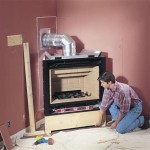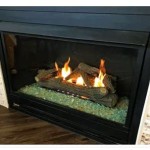Fireplace Screens With Fan: Enhanced Fireplace Efficiency and Safety
Fireplaces provide warmth and ambiance to a home, but they can also present safety concerns and inefficiencies if not properly managed. Fireplace screens are essential safety accessories that prevent sparks and embers from escaping into the room. Fireplace screens with integral fans offer an additional benefit: they enhance the distribution of heat generated by the fire, improving heating efficiency and reducing energy costs.
The integration of a fan into a fireplace screen is a relatively recent development, building upon the long-standing tradition of using screens for safety. Traditional fireplace screens protect against hazards but do little to improve heat transfer to the surrounding environment. The addition of a fan addresses this limitation, creating a forced-air system that circulates heated air more effectively. This article will explore the benefits, features, and considerations when selecting a fireplace screen with a fan.
Key Benefits of Fireplace Screens with Fans
Fireplace screens with fans offer multiple advantages compared to traditional screens. These benefits primarily revolve around enhanced safety, improved heat distribution, and potential energy savings.
First and foremost, safety remains a critical function. The screen itself, typically constructed of metal mesh, prevents sparks and embers from popping out of the fireplace and landing on flammable materials such as rugs, furniture, or clothing. This barrier significantly reduces the risk of fire hazards and property damage. The addition of a fan does not compromise this safety feature; the fan is typically enclosed and positioned to draw air from within the screen and expel it into the room, preventing any interference with the screen's protective function.
Secondly, improved heat distribution is a major advantage. Without a fan, much of the heat generated by a fireplace rises directly up the chimney, effectively wasted. A fireplace screen with a fan helps to redirect this heat into the room. The fan circulates the heated air, ensuring that it reaches further into the living space. This results in a more even and comfortable temperature throughout the room, reducing cold spots and improving overall heating efficiency. The fan essentially acts as a heat amplifier, maximizing the warmth generated by the fire.
Finally, the increased heating efficiency can translate into energy savings. By more effectively distributing heat, the fireplace can contribute more significantly to the overall heating of the home. This can reduce the reliance on central heating systems, particularly in rooms where the fireplace is frequently used. Although the fan itself consumes a small amount of electricity, the energy savings from reduced central heating use can often offset this cost, resulting in net energy savings over time. The amount of energy saved will depend on factors such as the frequency of fireplace use, the efficiency of the central heating system, and the size and insulation of the room.
Features to Consider When Choosing a Fireplace Screen with Fan
When selecting a fireplace screen with a fan, several features should be considered to ensure optimal performance, safety, and aesthetic appeal. These features include the screen's construction materials, fan specifications, design and dimensions, and safety certifications.
The construction materials of the screen are paramount in determining its durability and safety. The screen should be constructed from a sturdy, fire-resistant metal such as steel or iron. The mesh should be fine enough to effectively prevent embers from escaping, while still allowing adequate airflow. The frame surrounding the mesh should be robust and well-constructed to withstand the heat and stresses associated with fireplace use. The finish should be heat-resistant and durable to prevent corrosion or discoloration over time. Some screens may feature decorative elements or coatings, but it is important to ensure that these materials are also non-flammable and heat-resistant.
The fan specifications are crucial for determining the effectiveness of heat distribution. The fan's airflow capacity, measured in cubic feet per minute (CFM), indicates the volume of air it can circulate. A higher CFM rating generally indicates a more powerful fan capable of distributing heat over a larger area. The fan should also operate quietly to avoid creating an annoying background noise. Many models offer multiple fan speed settings, allowing the user to adjust the airflow according to their preferences and the intensity of the fire. The fan's power consumption should also be considered, as this will affect the overall energy efficiency of the unit. It is also important to check if the fan is easily replaceable should it fail in the future.
The design and dimensions of the screen should complement the fireplace and the overall décor of the room. Screens are available in a variety of styles, from traditional to contemporary, and in a range of finishes, such as black, brass, and brushed nickel. The dimensions of the screen should be carefully matched to the size of the fireplace opening. The screen should be wide enough to completely cover the opening, preventing embers from escaping around the sides. It should also be tall enough to provide adequate protection without obstructing the view of the fire. Consider the style of your fireplace and the overall aesthetic of your room when selecting a screen that complements the existing décor.
Safety certifications provide assurance that the screen has been tested and meets established safety standards. Look for certifications from recognized organizations such as UL (Underwriters Laboratories) or ETL (Electrical Testing Laboratories). These certifications indicate that the screen has been rigorously tested for fire resistance, electrical safety, and other relevant safety criteria. Checking for these certifications can help ensure that you are purchasing a safe and reliable product.
Installation and Maintenance of Fireplace Screens with Fans
Proper installation and maintenance are essential for ensuring the safe and effective operation of a fireplace screen with a fan. Installation typically involves simply placing the screen in front of the fireplace opening, but it is important to ensure that it is securely positioned and that the fan is properly connected to a power source. Regular maintenance includes cleaning the screen and fan to remove dust and debris, and inspecting the screen for any signs of damage.
Installation is generally straightforward and does not require professional assistance. The screen should be placed directly in front of the fireplace opening, ensuring that it completely covers the opening and that there are no gaps through which embers could escape. The screen should sit flush against the fireplace surround, if possible, to prevent drafts. The fan typically plugs into a standard electrical outlet. Ensure that the power cord is not placed near the fire or in a location where it could be tripped over. Some models may require minimal assembly, such as attaching the fan unit to the screen frame. Follow the manufacturer's instructions carefully during installation.
Regular cleaning is essential for maintaining the performance and appearance of the screen. Dust and soot can accumulate on the screen and fan blades, reducing airflow and potentially compromising the screen's fire resistance. Use a soft brush or vacuum cleaner attachment to remove dust and debris from the screen mesh and frame. The fan blades can be cleaned with a damp cloth or brush. Avoid using harsh chemicals or abrasive cleaners, as these can damage the finish of the screen. It is recommended to clean the screen and fan at least once a month, or more frequently if the fireplace is used regularly.
Regular inspection of the screen is also important for identifying any signs of damage or wear. Check for any holes or tears in the mesh, loose or broken welds, or corrosion on the frame. If any damage is found, the screen should be repaired or replaced immediately to ensure continued safety. Also check the fan for any unusual noises or vibrations, which could indicate a problem with the motor or bearings. If the fan is not functioning properly, it should be inspected and repaired or replaced as needed. Addressing any issues promptly can prevent further damage and ensure that the screen continues to provide effective protection.
Beyond the practical aspects of installation and maintenance, consider the overall integration of the fireplace screen with the existing elements of the living space. Ensure that the screen's design complements other fireplace accessories, such as tool sets and andirons, to create a cohesive and visually appealing hearth area. Placement of furniture should also be considered, ensuring that it is a safe distance from the fireplace and that the airflow from the fan is not obstructed. These considerations contribute to both the functionality and the aesthetic enjoyment of the fireplace and surrounding space.

Uniflame Polished Brass S Ornate Medium Fan Screen

Vintage Brass Peacock Fireplace Screen Cover Griffin Folding Fan Art Deco Gargoyle Antique Victorian

Italian Gilt Brass Pierced Folding Peacock Fan Fireplace Screen Or Fire For At Pamono

Vtg Brass Folding Peacock Fireplace Screen Fan Griffin Gargoyle Antique French

French Broe Fireplace Screen Fan Napoleon Iii Charles Casier Inventifdesigns

Antique 1920s Cameo Victorian Brass Peacock Fireplace Folding Fan Screen

Lot Brass Peacock Fan Fireplace Screen With Figural R

Peacock Fan Fire Screen Furniture La Maison Chic Luxury Interiors

Antique Brass S Motif Fireplace Screen For At 1stdibs Peacock Boho 1920s

Peacock Fireplace Screen Folding Fan Victorian Cameo 27 X 39 Brass Vintage








